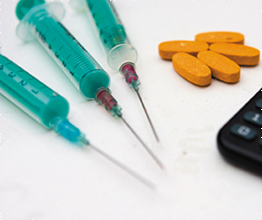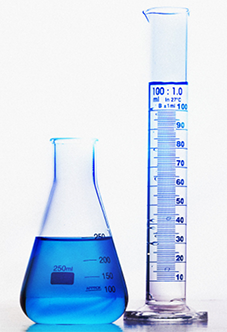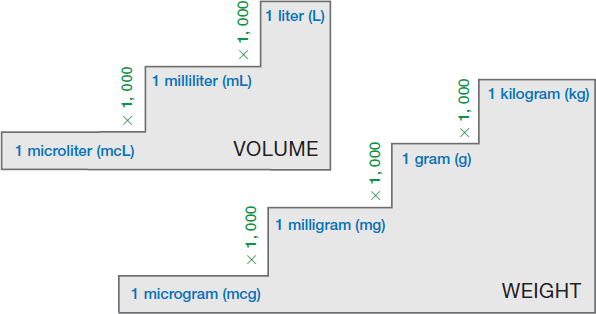6.6 Pharmaceutical Measuring: The Metric System
All those early common measurement systems were inconsistent and imprecise. Depending on which system was being used, practitioners were dispensing widely differing doses. For example, a pound in the apothecary system is equivalent to 12 ounces, whereas a pound in the avoirdupois and household systems is equivalent to 16 ounces. An apothecary ounce is 31.1 g, but an avoirdupois ounce is 28.35 g. These discrepancies led to many medication errors.
 Safety Alert
Safety Alert
An error of a single decimal place is an error by a factor of 10 and can have tragic results if not noticed.
Consequently, a standardized system was needed. The metric system was developed in France in the 1700s, and, by 1893, the United States designated it as the legal standard of pharmacy measurement. It is the international measuring system in pharmacy and other sciences, as it is the safest, most standard, most accurate, and easiest for conversions.
The metric system is based on multiples of ten, one hundred, and one thousand. Three basic units in the metric system are the meter (length and cubic volume), liter (fluid volume), and gram (mass/weight) as seen in Table 6.6.
The Benefits of the Metric System
The metric system has several distinct advantages over other measurement systems.
The metric system contains clear proportional correlations among the differing units of measurement of length, volume, and weight, which simplifies calculations. For example, the standard metric unit for volume, the liter, is almost exactly equivalent to 1,000 cubic centimeters, as seen in Table 6.6.
The metric system is based on decimal notation in which units are described as multiples of 10 (0.001, 0.01, 0.1, 1, 10, 100, 1,000). This decimal notation also makes calculations easier.
With slight variations in notation, the metric system is used worldwide, especially in scientific measurement, and therefore, like music notation, can be considered a “universal language.”

Injectable drugs in the hospital or oral dosage forms in the community pharmacy are prepared using the metric system. Calculators are used by technicians for accurate preparations, dosages, and conversions
Table 6.6 Common Metric Units
Measurement Unit |
Equivalent |
|---|---|
Length: Meter |
|
1 meter (m) |
100 centimeters (cm) |
1 centimeter (cm) |
0.01 meter (m); 10 millimeters (mm) |
1 millimeter (mm) |
0.001 meter (m); 1,000 micrometers or microns (mcm) |
Volume: Liter |
|
1 liter (L) |
1,000 milliliters (mL); 1,000 cubic centimeters (cc) |
1 milliliter (mL) |
0.001 liter (L); 1,000 microliters (mcL) |
Weight: Gram |
|
1 gram (g) |
1,000 milligrams (mg) |
1 milligram (mg) |
0.001 grams (g); 1,000 micrograms (mcg) |
1 kilogram (kg) |
1,000 grams (g) |
Applying Metric Units
The most commonly used metric units for pharmacy are applied to measuring liquid volumes in liters and mass/weight in grams. Meters are rarely used, but it is important to understand how they relate to the rest of the metric system. (Outside of the pharmacy, the common metric measurements used are a meter for length/distance as in kilometers for a running race; liters for measuring liquids as in 2 L bottles of juice or soda; grams for the weight of bags of sugar or flour.)
Meters
The meter is used not only in measuring distance, but also area and volume. Distance is measured by a single length, whereas area is two-dimensional flat space measured by two lengths multiplied (length and width); and volume, which is three-dimensional space, is measured by three lengths multiplied (length, height, depth—or width—resulting in cubic meters and cubic centimeters [abbreviated as cc]).
 For Good Measure
For Good Measure
The cubic centimeter (cc) is the one metric measurement being phased out in pharmacy practice because it can cause confusion and errors; sometimes it looks like two extra zeros. It is being replaced by liter measurements: 1 cc of volume is approximately equal to 1 mL of liquid volume, which is one-thousandth of a liter.
Liters
The liter (L) is the base unit of measurement for the volume of liquid medications for oral and parenteral solutions. It is often broken down into smaller units: the milliliter (mL), or one thousandth of a liter, and microliter (mcL), or one millionth of a liter. For example, you may fill a prescription for an antibiotic for administration of 4 mL by mouth every 12 hours for 10 days. In the hospital or home healthcare setting, you could prepare a solution of 1 g antibiotic cefazolin in a 50 mL sterile saline IV solution to be administered over 30 minutes.

Pharmaceutical volumes are usually expressed in milliliters. To measure nonsterile liquids, volumetric flasks of varying sizes are used, such as those pictured here.
Grams
The gram is the weight of 1 cubic centimeter of water at 4°C. It used in pharmacy for:
measuring the weight of the amount of medication in a solid dosage form
indicating the amount of solid medication in a solution
expressing the weight of a patient or in a counterbalance measuring weight
Pharmaceutical dosages are commonly expressed in grams (g) or milligrams (mg). For example, you may fill a prescription for 1 g tablet per day of the anti-ulcer medication sucralfate or prepare a 600 mg antibiotic suspension of amoxicillin/clavulanate to be reconstituted or mixed with 5 mL sterile water.
Standard Proportional Prefixes
As explained, these different metric units of measurement come in powers of ten. Prefixes, or syllables placed at the beginnings of words, are added to the names of the basic metric units to specify a particular size of unit measure, such that milli- (meaning 1,000) can be added to liter to form a new unit milliliter or one-thousandth of a liter.
 For Good Measure
For Good Measure
Some students remember the order of metric prefixes by remembering the first letters of the phrase: King Henry Died By Drinking Chocolate Milk, MOOOOOO!
The set of standardized metric prefixes based on powers of 10 is called the Système International (SI)—(see Table 6.7). Each of these metric units has its own abbreviation, which is the same for both single and plural measurements (for example, 1 mL, 3 mL; 1 g, 3 g). Each prefix is affixed to a basic unit of measurement, such as a liter, meter, or gram. In contemporary pharmacy, the prefixes centi-, deca-, deci-, and hecto- are rarely if ever used. (You can see how the abbreviations for deca and deci could easily be mixed up, resulting in a difference of a 100 times!) In prescriptions with metric numbers, decimals are used rather than fractions.
TABLE 6.7 Systeme International Prefixes
Prefix |
Symbol |
Meaning |
|---|---|---|
kilo- |
k |
one thousand times (basic unit × 103, or unit × 1,000) |
hecto-* |
h |
one hundred times (basic unit × 102, or unit × 100) |
deca-* |
da |
ten times (basic unit × 10) |
no prefix (liter, gram, or meter) |
L, g, or m |
base unit |
deci-* |
d |
one-tenth (basic unit × 10-1, or unit × 0.1) |
centi-* |
c |
one-hundredth (basic unit × 10-2, or unit × 0.01) |
milli- |
m |
one-thousandth (basic unit × 10-3, or unit × 0.001) |
micro- |
mc or μ |
one-millionth (basic unit × 10-6, or unit × 0.000001) |
* These units are generally not used in pharmacy. |
||
 Safety Alert
Safety Alert
To avoid dangerous mixups, deca- and deci- are prefixes not being used in pharmacy practice. Hecto- is rare too.
Converting to Proportionally Larger or Smaller Units
The most common calculations in pharmacy involve conversions up to higher proportional amounts and down to lower ones using milligrams, grams, and kilograms, or milliliters and liters. Multiplying or dividing by 1,000 takes you up and down the unit steps. After properly doing your calculations, you end up moving the decimal point positions to the left to convert to larger units or to the right to convert to smaller units. Figure 6.3 and Table 6.8 show how these conversions work. To double-check your calculated conversions, count the correct decimal places to the right or left.
 Practice Tip
Practice Tip
See the link below for a video with easy-to-learn stair-step conversions of kilograms, grams, milligrams, and micrograms: https://PharmPractice7e.ParadigmEducation.com/MetricConversion.
Note that an error of a single decimal place is an error by a factor of 10. Therefore, you must exercise due diligence when recording, interpreting, transcribing, and measuring medication dosages containing metric decimals, because even minor errors can lead to serious medication errors. As noted earlier, for numbers less than one (1), a leading x or a zero (0) must be placed before the decimal point to prevent misreading, as in digoxin X .25 or 0.25 mg.
Figure 6.3 Steps Worth a Thousand
Metric units of measurement go up and down by steps of 1,000. Remember each step is separated by three decimal places, by a power of one thousand. To go to smaller measurements, move from left to right. For larger ones, move from right to left.

TABLE 6.8 Common Metric Conversions
Conversion |
Instruction |
Example |
|---|---|---|
kilograms (kg) to grams (g) |
multiply by 1,000 (move decimal point three places to the right) |
6.25 kg = 6,250 g |
grams (g) to milligrams (mg) |
multiply by 1,000 (move decimal point three places to the right) |
3.56 g = 3,560 mg |
milligrams (mg) to grams (g) |
multiply by 0.001 (move decimal point three places to the left) |
120 mg = 0.120 g |
liters (L) to milliliters (mL) |
multiply by 1,000 (move decimal point three places to the right) |
2.5 L = 2,500 mL |
milliliters (mL) to liters (L) |
multiply by 0.001 (move decimal point three places to the left) |
238 mL = 0.238 L |
microliters (μL or mcL) to milliliters (mL) |
multiply by 1,000 (move decimal point three places to the left) |
1,000 μL or mcL = 1 mL |
 IN THE REAL WORLD
IN THE REAL WORLD
A42-year-old patient with breast cancer in Florida was given a good prognosis as she was responding well to chemotherapy. Her doctor prescribed warfarin, a blood thinner, due to a high risk of blood clots. The uncertified technician typed in 10 mg instead of 1 mg. Unfortunately, the inaccurate prescription (with a tenfold dosage error) was filled and dispensed, and the mother of three experienced a brain bleed; she suffered a stroke and fell into a coma after 23 days of treatment.
Once out of the coma, she had to relearn to eat, talk, walk, and do other tasks. Sadly, she was too weak to continue her cancer treatments, and she died four-and-a-half years after taking her prescription. The civil court decision required the pharmacy to pay $25.8 million dollars to the bereaved family. The chain pharmacy appealed and lost the case, with the court awarding the family $33 million.